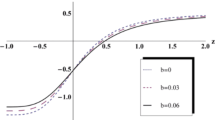Abstract
Dark energy is the dominant component of the total energy density of our Universe. The primary interaction of dark energy with the rest of the Universe is gravitational. It is therefore important to understand the gravitational dynamics of dark energy. Since dark energy is a low-energy phenomenon from the perspective of particle physics and field theory, a fundamental approach based on fields in curved space should be sufficient to understand the current dynamics of dark energy. Here, we take a field theory approach to dark energy. We discuss the evolution equations for a generic dark energy field in curved space-time and then discuss the gravitational collapse for dark energy field configurations. We describe the 3 + 1 BSSN formalism to study the gravitational collapse of fields for any general potential for the fields and apply this formalism to models of dark energy motivated by particle physics considerations. We solve the resulting equations for the time evolution of field configurations and the dynamics of space-time. Our results show that gravitational collapse of dark energy field configurations occurs and must be considered in any complete picture of our Universe. We also demonstrate the black hole formation as a result of the gravitational collapse of the dark energy field configurations. The black holes produced by the collapse of dark energy fields are in the supermassive black hole category with the masses of these black holes being comparable to the masses of black holes at the centers of galaxies.
Similar content being viewed by others
References
M. J. Pierce, D. L. Welch, R. D. McClure, et al., Nature 371, 385 (1994).
W. L. Freedman, B. F. Madore, J. R. Mould, et al., Nature 371, 757 (1994).
Anupam Singh, Phys. Rev. D 52, 6700 (1995).
A. K. Gupta, C. T. Hill, R. Holman, and E. W. Kolb, Phys. Rev. D 45, 441 (1992).
G. ’t Hooft, in Recent Developments in Gauge Theories (Plenum, New York, 1980).
R. Holman and A. Singh, Phys. Rev. D 47, 421 (1993).
E. W. Kolb and M. S. Turner, The Early Universe (Addison-Wesley, Redwood City, 1990).
S. Weinberg, Gravitation and Cosmology (Wiley, New York, 1972).
J. Balakrishna, R. Bondarescu, G. Daues, et al., Class. Quantum Grav. 23, 2631 (2006).
M. Alcubierre, B. Breugmann, T. Dramlitsch, et al., Phys. Rev. D 62, 124011 (2000).
T. W. Baumgarte and S. L. Shapiro, Phys. Rev. D 59, 024007 (1998)
M. Shibata and T. Nakamura, Phys. Rev. D 52, 5428 (1995).
F. Loffler, J. Faber, E. Bentivegna, et al., Class. Quant. Grav. 29, 115001 (2012).
J. Thornburg, Phys. Rev. D 54, 4899 (1996).
Author information
Authors and Affiliations
Corresponding author
Additional information
The article is published in the original.
Rights and permissions
About this article
Cite this article
Jhalani, V., Kharkwal, H. & Singh, A. Gravitational collapse of dark energy field configurations and supermassive black hole formation. J. Exp. Theor. Phys. 123, 827–831 (2016). https://doi.org/10.1134/S1063776116130148
Received:
Published:
Issue Date:
DOI: https://doi.org/10.1134/S1063776116130148



